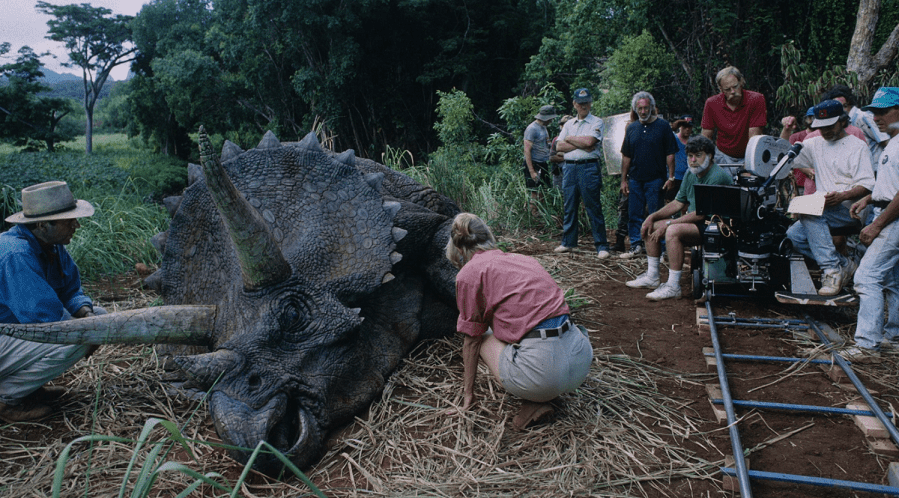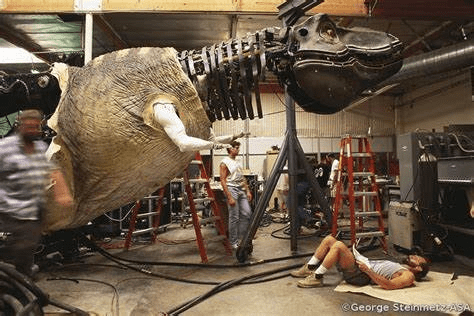Rights to make a film based on Michael Crichton’s novel, Jurassic Park, were bought by Universal Pictures and Amblin Entertainment even before it was published. The concept for the novel began in 1983 but its premise of being from a young boy’s perspective was not well-received. The perspective was changed and interest grew. Described as a science-fiction film, Jurassic Park was released in 1993.
In order to create the very basis of the film, the dinosaurs, Steven Spielberg wanted to enlist Robert Gurr, an American amusement ride designer and engineer. Gurr designed a King Kong for Universal Studios Hollywood. Further thought into the idea led Spielberg to think they may not be as convincing as he wanted so he contacted Stan Winston to create animatronic dinosaurs. Phil Tippett, who worked on the Star Wars trilogy, was also brought onto the project. Tippett would be the Dinosaur Supervisor and would film long shots in go-motion, a variation of stop motion which incorporates motion blur to make the action seem more realistic. Dennis Muren, who also worked on Star Wars, was hired to do digital compositing. Michael Lantieri, a special effects supervisor who worked with Spielberg on Indiana Jones and the Lost Crusade, supervised on-set effects.

Spielberg hired Jack Horner, a paleontologist, to supervise the designs and make the dinosaurs more like animals and less like monsters. With Horner’s help, Winston created detailed models of the dinosaurs, each covered with molded latex skins. Tippett was responsible for the raptors stalking the children in the kitchen and the tyrannosaurus attacking the car. In spite of the success of go-motion, Spielberg wanted a much more realistic look and feel. Muren suggested using CGI and tasked ILM to come up with a way to do it.
In an interesting side note, upon seeing the animation, Spielberg told Tippet, “You’re out of a job.” Tippett replied, “Don’t you mean, extinct?” This discourse found its way into the film as an exchange between two of the characters.
Tippett supervised the movement of the dinosaurs without the use of go motion. The animators were trained as computer animators and used storyboards as a reference for what would be shot. ILM artists studied elephants, alligators, and giraffes to get a feel for animalistic movement. Artists also took mime classes to better understand basic movement.

Many people, upon seeing the film, thought the dinosaurs were all CGI. Newer audiences to the older film may think the same. However, many of them were physical models and/or puppets. The dilophosaurus, the frilled creature Dennis Nedry encounters, was an animatronic model. Puppeteers in a trench created the “spitting” effect by using a paintball mechanism, firing methyl cellulose (a thickener and emulsifier) and K-Y Jelly. Contrary to what the movie shows, the dilophosaurus was taller, did not have a frilled neck, and did not spit venom.
Combining the sounds of a rattlesnake, a hawk, a swan, and a howler monkey gave the dilophosaurus its distinctive vocal sound.
The gallimimus was the first of the dinosaurs to be digitized. The design, based on ostriches, was meant to reinforce the theory of dinosaurs being more like birds than lizards. The animation’s focus was on the collective nature, not the individual one. The animators ran through the ILM parking lot and footage of their run inspired the herd animation. It even incorporated the part where one of the animators fell while trying to jump the plastic pipe which stood in for the fallen tree they jump over while evading the tyrannosaurus.
The velociraptor was very much smaller than the ones depicted in the film. For most of the attack sequence and the kitchen scene, men in creature suits portrayed the creatures.

Sounds of hissing geese, mating tortoises, human rasps, bellowing walruses, and screaming dolphins were used for the different sounds made by velociraptors.
The triceratops was an animatronic creation, operated by eight puppeteers. It was also one of the first to be filmed. Winston created the larger dinosaur, as well as, a baby. The triceratops vocals were created by Gary Rydstrom breathing into a tube and mixing the sound with cows.

The “star” of Jurassic Park was a Winston creation which stood almost twenty feet, was forty feet long, and weighed seventeen thousand, five hundred pounds. Physical movement for the tyrannosaurus did not align with what paleontologists thought possible since it had hollow bones, which would not support its great weight. Animator, Steve Williams went for the dramatic effect over the realistic facts. The idea of the creature having vision based on movement was also untrue, as they are thought to have had binocular vision, more like a bird of prey.
The roar of the tyrannosaurus was a combination of sounds form a baby elephant, a tiger, and an alligator. Its grunting sounds were a male koala and the breath of the creature is from a whale’s blow.

One of the simplest effects of the film was the concentric “tremor” circles in the water glass. Inspired by the music of Earth, Wind, and Fire, Spielberg thought this would build tension with the audience. Lantieri remained baffled as to how to create the shot until he put a glass of water on a guitar while he was playing it. Guitar strings were then put into the car and plucked, when needed.
ILM used Dinosaur Input Devices, models which allowed the animators to imitate stop-motion puppets. Information was fed into computers rather than having to move the models by hand. Rendering the dinosaurs took around two to four hours per frame. The tyrannosaurus in the rain took almost six hours – per frame. Compositing the dinosaurs into live-action shots took only an hour. ILM also created a lot of the smaller effects, like splashing water and digital face replacements for some of the actors.
In all of the one hundred and twenty minutes of the film, an average of about six minutes is CGI. Spielberg wanted to use these effects as “last minute” ones, not the ones driving the film.
Software called Viewpaint allowed color and texture to be put onto the computer models in a much more direct, and less time-consuming way. Pixar uses a program called RenderMan which is a 3D animation software. It was used on some of the dinosaur effects, as well.
George Lucas supervised the sound effects crews.





